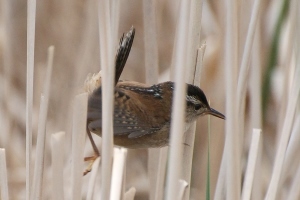Wetlands Month featured creature: the marsh wren
 May is American Wetlands Month – a month to appreciate and enjoy the wonders of wetlands! Take some time to experience this amazing native ecosystem by visiting one of Michigan’s Wetland Wonders. There, you may find one of Michigan’s most secretive birds: the marsh wren. May is American Wetlands Month – a month to appreciate and enjoy the wonders of wetlands! Take some time to experience this amazing native ecosystem by visiting one of Michigan’s Wetland Wonders. There, you may find one of Michigan’s most secretive birds: the marsh wren.
When visiting wetlands, you are more likely to hear a marsh wren’s squeaky, old-sewing-machine-sounding song than you are to see the wren. These secretive birds zip among the tall stems of cattail marshes looking for flying insects, including dragonflies and damselflies. If you are lucky enough to catch a glimpse, it will be a quick one, before the wren heads back into thick cover.
Marsh wrens are tiny birds – only about 5 inches long. Their plumage is largely brown, with reddish shoulder and rump patches, a black triangle on the upper back streaked with white, a bold white eyebrow, and a white chin and belly. Also look for the characteristic wren tail – wrens often hold their tails straight up in the air as opposed to horizontally.
In our state, marsh wrens arrive in April, spend the spring and summer in Michigan’s marshes, and head south to the Gulf states and Mexico for the winter. They build globe-shaped nests – woven from cattail, bulrush, weed and grass stems – in the cattails and line their nests with down from the hot-dog-shaped brown cattail flower. Marsh wrens will build several decoy nests within their territory to help keep predators from finding their real nest.
The female lays a brood, four to six white to pale brown eggs, and incubates the eggs for about two weeks before they hatch. The youngsters grow quickly and set out on their own less than a month after they hatch! Female marsh wrens raise two broods per year.
To increase the chances that his offspring will survive with little competition, male marsh wrens often will puncture the eggs of other birds in the marsh. Nest-destruction targets may be other marsh wrens, red-winged blackbirds, yellow-headed blackbirds and least bitterns.
These fascinating birds can be found in many of Michigan’s wetlands, including Michigan’s Wetland Wonders. To learn more about these areas, visit www.michigan.gov/wetlandwonders.
Michigan’s state game and wildlife areas are free to wildlife watchers. Hunting license fees pay for habitat management at these areas. Even if you are not a hunter in the traditional sense, consider purchasing an $11 base license to help the creatures you hunt with your binoculars, cameras and spotting scopes.
/Note to editors: Contact – Holly Vaughn, 313-396-6863. An accompanying photo is available below for download.
Suggested caption: The marsh wren is a secretive bird of cattail wetlands./
The Michigan Department of Natural Resources is committed to the conservation, protection, management, use and enjoyment of the state’s natural and cultural resources for current and future generations. For more information, go to www.michigan.gov/dnr.
|

 May is American Wetlands Month – a month to appreciate and enjoy the wonders of wetlands! Take some time to experience this amazing native ecosystem by visiting one of Michigan’s Wetland Wonders. There, you may find one of Michigan’s most secretive birds: the marsh wren.
May is American Wetlands Month – a month to appreciate and enjoy the wonders of wetlands! Take some time to experience this amazing native ecosystem by visiting one of Michigan’s Wetland Wonders. There, you may find one of Michigan’s most secretive birds: the marsh wren. 




